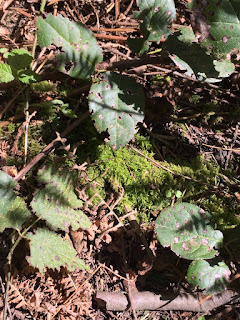The 1120 Lab Section of Bio 213 set out to uncover new things about the mysterious world of fungi in the forest. Lead by the fearless Korena, fungi high inquisitor, the students would learn that from fungi, there is no escape...
Lichens
One of the first things Korena pointed out to us were examples of lichens. Lichens are actually cyanobacteria or algae working with fungi and growing in their filaments. Korena pointed out examples of powder and crusty lichen that were growing on the same tree and continued to point others out for the duration of the trip.
Blight
Dark spots on the leaves of several plants were identified as plant blight, a symptom of infection with pathogenic organisms, a common category of which are pathogenic fungi. Blight presence indicated that the plant was sick.
Korena pulled a small root off of one of the felled trees along the trail and talked about how root tips are where the mycorrhizal fungi usually intersect with the trees. She explained the difference between ectomycorrhiza and arbuscular ( Endo-) mycorrhiza, in that ectomycorrhiza for a hyphae sheath and fruiting bodies outside of the root, but endomycorrhiza form their hyphae within the cell membrane.
Later on when talking about the Amanita mushroom, she mentioned that trees have the ability to break off mycorrhizal relationships in situations that stress them or resources.
Moss vs Lichen
Korena pointed out the differences between mosses and lichen with mosses being non-vacular plants and lichens as a form of fungi and algae relationship. It was noted that many mosses rely on saprophytic fungi to establish suitable soil for them, both among the leaf litter and much high up in the tree canopies.
Ducks
DO NOT FEED DUCKS BREAD. IT GIVES THEM BOTULISM.
Brown Rot
Only briefly mentioned, but brown rot is a type of saprophytic fungi that was breaking down dead wood in one of the trees we saw.
Polypore
Fungi with fruiting bodies that often grow on fallen logs, these guys make what are known as conks - tough, lignin heavy, mushrooms. Unlike other fungi, polypores disperse their spores via tubes and not gills. Korena stressed that pore size is very important for fungi and mushroom classification and that polypores were excellent for that purpose.
Korena managed to locate an mushroom for a fungi from the Amanita genus, which is in the Basidiomycota division. The death cap and death angel are also from the Amanita genus! Korena hypothesised it might be either Amanita gemmata or Amanita Pantherina but that she wouldn't say for sure unless she had looked at the spores. She stressed that Amanita's are basically never safe to eat and the deadly ones usually kill people ~two weeks after consumption via liver failure.
 Korena walked through the anatomy of the mushroom she found, specifically mentioning the annulus (ring structure on the stipe) and gills. She talked about how there's many, many characteristics that can used to identify the mushrooms.
Korena walked through the anatomy of the mushroom she found, specifically mentioning the annulus (ring structure on the stipe) and gills. She talked about how there's many, many characteristics that can used to identify the mushrooms.
We left the park that day wiser to the presence and importance of the fungi living around us and the importance they had to the ecosystem. Never again will we understand the role of fungi in mychorrhizal, saprophytic, parasytic and mutualistic forms again!!!!
Really though, it was a super cool time.
PS. I have footage for this entire trip, I just haven't had time to cut it yet! Will edit to include it asap :3c







No comments:
Post a Comment